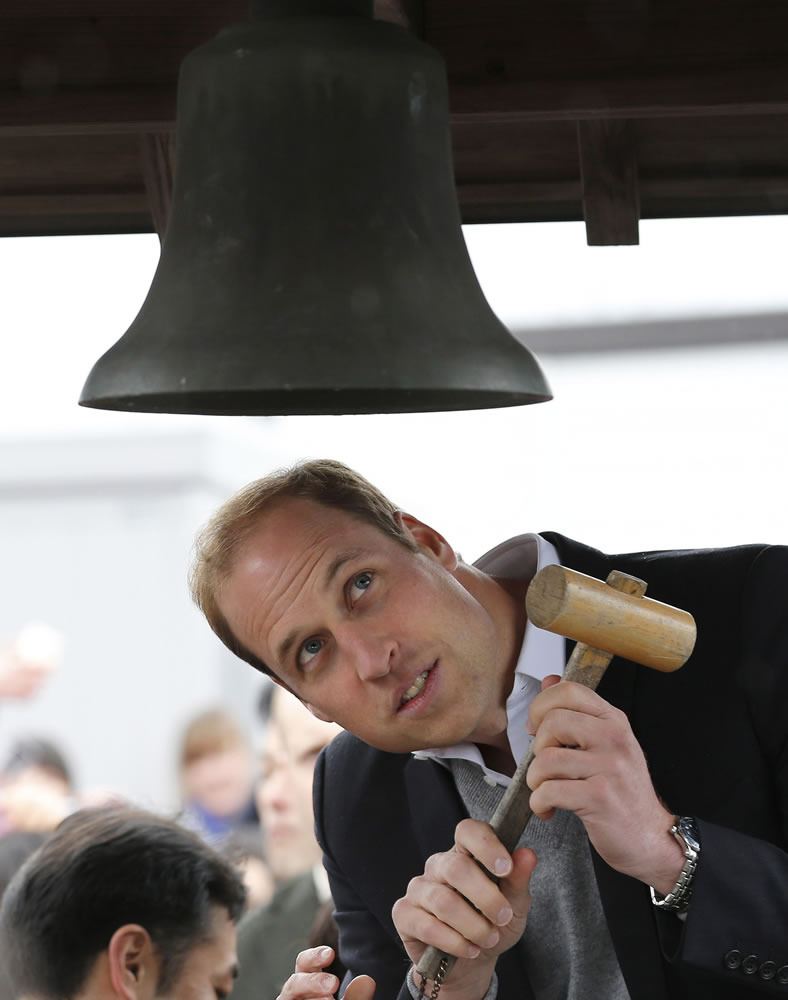ISHINOMAKI, Japan — Britain’s Prince William stood atop a hill in northeastern Japan on Sunday, and stretched below him was barren land known as the “Bay of Destruction,” which was swept by a tsunami four years ago.
On the last leg of his four-day visit to Japan, William laid a bouquet near a shrine gate that overlooks the bay, to commemorate the victims. Of the nearly 19,000 people who died in the March 2011 earthquake and tsunami, nearly 3,300 were residents of the coastal town of Ishinomaki. About 22,000 lost their homes.
The tragedy of Ishinomaki has been repeated across the shoreline, where communities are still trying to rebuild, mourning lost lives and worried about the future, as the younger generation leaves in droves. Thousands of people are still living in temporary housing, and many are dependent on aid for food and clothing.
William, who earlier visited more lively and modern spots in Tokyo, had insisted that his first-ever trip to Japan include the tsunami-stricken region.
Teruko Sekiguchi, a 42-year-old housewife and Ishinomaki resident, waited for the prince’s arrival on top of the hill in the cold rain for more than an hour. She said she was touched that he would come all the way out to the disaster region.
“He is gorgeous. You can feel his kindness,” she said.
When the tsunami hit, Sekiguchi fled to a nearby junior high school and waited for a week, feeling miserable, not even knowing whether her husband, a schoolteacher, had survived. When he finally came to find her, she was so overjoyed she just cried and couldn’t even walk toward him, she recalled.
Although the area below the hill, previously filled with small homes, has been cleaned of debris, no one will live there again. Plans are still being studied to turn it into a park.
“It’s like the area has been finally cleaned up enough into a white canvas so we can start painting on it,” said Kimio Abe, 76, who heads a company that installs heating and air conditioning units.
Abe was also among the crowd of about 80 people waiting on the hilltop for the prince. Abe’s home, near the hill, was half destroyed by the tsunami, but he fixed it and still lives in one room with his wife.
Earlier in the day, William visited a local newspaper that had produced handwritten newsletters right after the tsunami to keep communication going.
William wanted to know what the journalists had done, what the rescue operation was like, as well as the personal background of Hiroyuki Takeuchi, a journalist, now retired, at the Ishinomaki Hibi newspaper, who gave him a guide of the newsroom.
“It remains with you forever,” William told Takeuchi. “You remember where you were. It must have been unbelievably terrifying for you and all the others.”
After the visit, Takeuchi said he was moved by the intense interest William had shown in the region’s plight. “I am happy and I am honored,” he said.
William also met Shinichi and Ryoko Endo, who lost their three children, Hana, Kana and Kanta, all of them under 12. Endo, a carpenter working on the reconstruction of the area, gave William a wooden charm made of tsunami rubble.
William later went to another tsunami-hit coastal town, Onagawa, where he was welcomed by a traditional lion dance to the cheerful music of wooden flutes and drums.
At a humble shopping area that sold local goods by storekeepers trying to turn their lives around, he rang a bell that had survived the tsunami, called the “Chime of Hope.”
“His visit will not only provide a much-needed boost in morale for the people living in the region, but also reassurance that their plight has not been forgotten,” said Akemi Solloway, founder of London-based Aid for Japan, which supports tsunami orphans.
William returned by bullet train to Tokyo, where he later left for Beijing.



